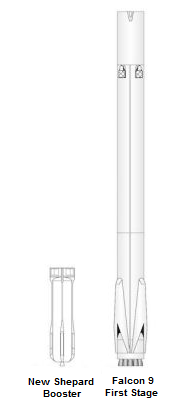SpaceX Succeeds in Soft Landing the First Stage of its Falcon 9 Launch System
Several weeks ago, I blogged about how Jeff Bezos has managed to get his New Shepard launch system to take off and then land vertically back on the launch pad. The ability to recover and reuse a rocket is a major breakthrough in human exploration and exploitation of space. The lower cost of launch and the ability to relaunch rapidly will be a boon to the space industry.
SpaceX, founded by Elon Musk is a major player in the race for private space capability. Their Falcon 9 launch vehicle has been successful in obtaining government projects such as satellite launches and supply runs to the International Space Station. SpaceX has made two failed attempts to vertically land the first stage of a Falcon 9 on a barge anchored at sea. Last week on December 21st, they succeeded in landing the first stage of a Falcon 9 back on the launch pad that the rocket took off from. At first glance, it would appear that Jeff Bezos beat Elon Musk to this important private space mile stone but, as often is the case, the truth is more complicated than the headline.
The New Shepard launch vehicle is much smaller than the Falcon 9. It is intended to go up sixty two miles and then return to Earth. This is not high enough to reach Earth orbit. The New Shepard is intended to carry people on suborbital flights. The Falcon 9 is designed to send payloads all the way to Earth orbit. New Shepard is short and compact with a length of fifty feet and a diameter of twenty two feet. The Falcon 9 first stage has to be much thinner than the New Shepard to cut through the atmosphere. It has a height of about one hundred and forty feet with a diameter of twelve feet. Overall, the Falcon 9 first stage is much more massive than the New Shepard, four hundred tons to one hundred and sixty five thousand tons.
New Shepard's engine generates about one hundred thousand pounds of thrust. Falcon 9 engine produces over a million and a half pounds of thrust. The Falcon 9 test launch reached one hundred and twenty four miles in altitude, about twice the height reached by New Shepard. The first stage of the Falcon 9 did not go into orbit. At its maximum velocity, the Falcon 9 was travelling about Mach Six, twice as fast as the Mach Three of New Shepard. New Shepard remained mostly vertical for its entire flight. Falcon 9 wound up traveling horizontally at the top of its trajectory. This meant that SpaceX had to carry out complex maneuvers to bring it back to a vertical position.
Landing the Falcon 9 first stage upright was much more difficult than landing the New Shepard upright. It had to descend further, it had to change orientation, it was traveling faster and it was much more massive. While New Shepard did land vertically first, landing Falcon 9 vertically was a much more challenging task. Both companies deserve credit for what they accomplished. The competition between these two private space companies can only benefit the growth of the private space industry.
Comparison between New Shepard and Falcon 9 first stages:
